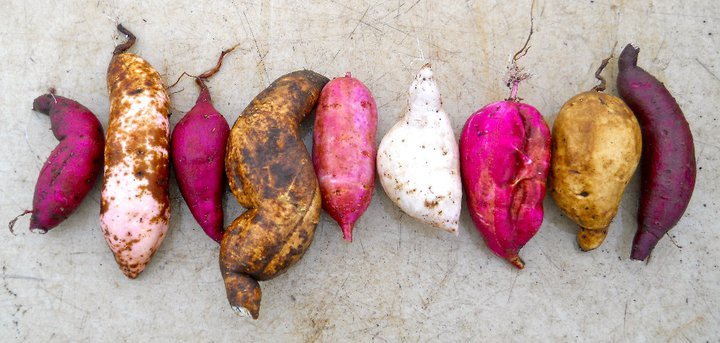A year-round staple in our islands will soon take center stage on many Thanksgiving dessert tables. The sweet potato is often overlooked, with favor leaning towards the more popular pumpkin pie. Still, its origins weave a fascinating history which include Poynesian voyagers, territorial farmers, invasive species, and celebration of African American culture . Follow the journey of this humble root in Hawaii and beyond.
The sweet potato (Ipomoea batata) is a part of the morning glory family and can grow from sea level to over 2,000 feet. The root (potato) is high in carbohydrates, beta-carotene, and vitamins, and the edible leaves are high in protein, making it an ancient and modern-day superfood. It grows in a variety of soils and withstands drought, making it a staple in ancient Hawaiʻi. Hawaiians had developed over 250 varieties of sweet potato- ʻuala in Hawaiian- which ranged in color from yellow, orange, red, purple, and white. Its importance is emphasized in the ʻŌlelo Noʻeau (Hawaiian proverb) “He ʻuala ka ʻai hoʻola koke i ka wī (The sweet potato is the food that ends famine quickly). But how did uʻala get here?
Using DNA analysis, French researchers from the Center for Functional and Evolutionary Ecology found that Hawaiʻiʻs sweet potato originated high in the South American Andes mountains. To get an accurate sample of pre-contact potatoes, they analyzed the dried remains of ʻuala from Captain James Cook’s voyages in 1796. They traced the genetic blueprint of these samples to Ecuador and Peru. In addition to indigenous, archaeological, and linguistic knowledge, ʻuala’s genetic evidence showed that Polynesian voyagers interacted and traded with natives in South America. After the Hōkūleʻa’s worldwide voyage from 2013-2018, the ability of ancient Polynesian voyagers to make a trip like this was no longer up for debate; however, the humble sweet potato offers further evidence that these highly skilled ancient wayfarers were able to make a journey of this magnitude.

ʻUala was an essential famine food and crop in ancient Hawaiʻi but was also significant to modern economies. Commercial cultivation of sweet potatoes first began in 1849. In 1919, it was grown as one of the top ten emergency foods during the World War (replacing white potatoes and used as livestock feed). But, despite being extensively cultivated in Hawaiʻi, the ancient Hawaiian varieties were being lost. By 1923, only 70 known species remained. Today, there are only about 24.
By the 1990s, just over 1,000 acres of sweet potato were in cultivation in Hawaiʻi, generating over $7 million for the economy. In 2016, farmers had less than 500 acres in sweet potato statewide, generating just under $2 million.
The reason why? Pests – primarily sweet potato weevils. These ½ inch, ant-looking insects are the most significant pests to sweet potatoes worldwide. The larvae channel the potato roots, and high concentrations can result in hundreds of larvae feeding on just one potato. This makes the potato unmarketable and inedible (the root becomes bitter in response to the pest damage). Sweet potato weevils are not the only potato plagues- the sweet potato bug, leaf miners, vine borers, hornworms, and nematodes are others. There is hope though. Researchers at the University of Hawaiʻi at Mānoa have recently discovered two Hawaiian varieties showing promising results in flavor, yield, and pest resistance. Perhaps the sweet potato may become an agricultural staple in Hawaiʻi yet again.


As a staple on the holiday dinner table, sweet potato pie is widely beloved. Although indigenous peoples cultivated sweet potatoes in the Pacific and the Americas centuries before the first Thanksgiving, sweet potato pies as a holiday tradition stems from Southern plantation kitchens, baked by enslaved African Americans. After emancipation, recipes followed freed peoples throughout the country, remaining a holiday favorite in African American communities today. But the love of sweet potato pie reaches far and wide and has made its way back to Hawaiʻi. Try this tropical twist on the traditional sweet potato pie this Thanksgiving: a Sweet Potato Haupia Bars recipe by Maui-based Instagram and YouTube cooking star Relle Lum (@keeping.it.relle) at keepingitrelle.com/sweet-potato-haupia-pie-bars.
Serena Fukushima is the public relations and education specialist for the Maui Invasive Species Committee. She holds a bachelor’s degree in environmental studies and a graduate degree in education from the University of Hawaii at Manoa. “Kia’i Moku, Guarding the Island” is written by the Maui Invasive Species Committee to provide information on protecting the island from invasive plants and animals that threaten our islands’ environment, economy and quality of life.
This article was originally published in the Maui News on November 12, 2022 as part of the Kia‘i Moku Column from the Maui Invasive Species Committee.
Read more Kiaʻi Moku articles
